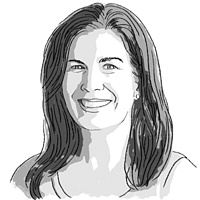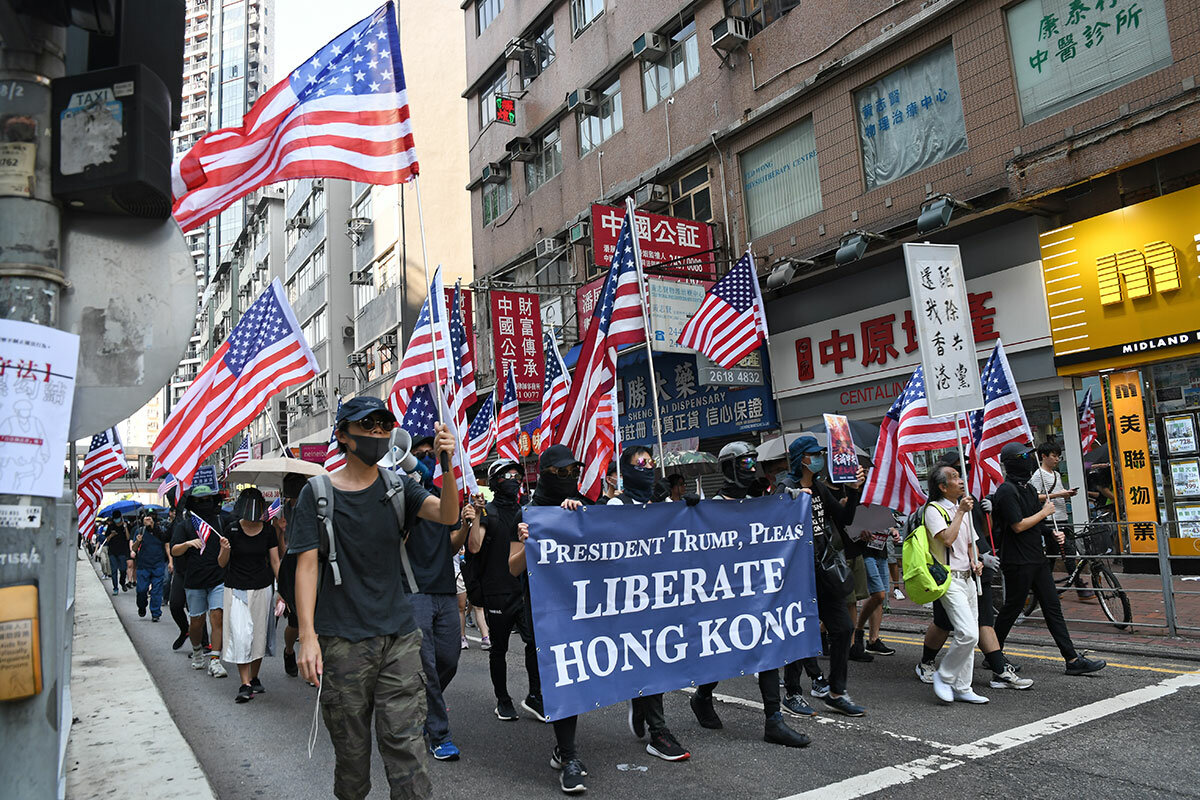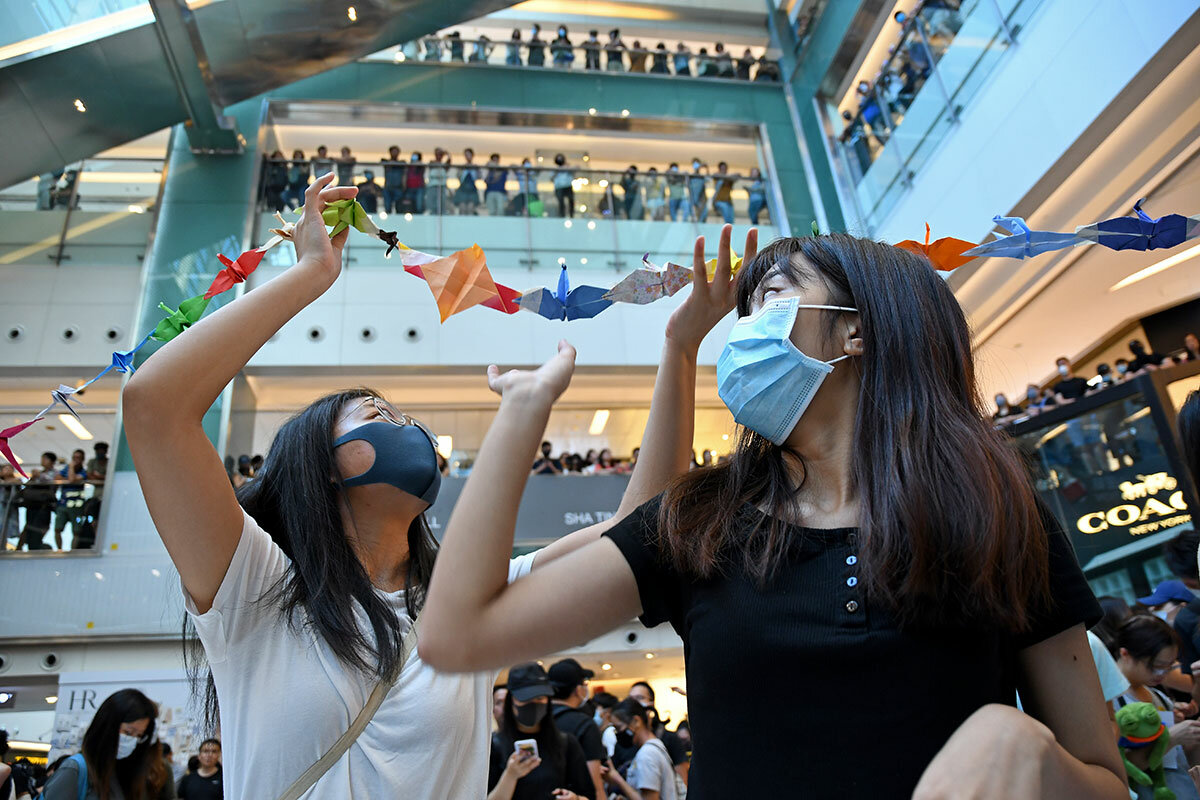‘Freedom is in our mind’: Why Hong Kong protests are still escalating
Loading...
| Hong Kong
Wearing a black T-shirt, black pants, and a surgical mask to hide her face, Valerie folds a delicate pink origami crane, crafting the bird that represents happiness together with thousands of other pro-democracy protesters packing a Hong Kong mall on Sunday.
The group quickly fashions more than 1,000 of the paper cranes, a tradition to make a wish come true. With the little figures, they build one huge, multicolored bird that they hoist skyward to the cheers of the gathered crowd.
But the day that begins with a peaceful shopping boycott and a wind ensemble playing the protesters’ anthem, “Glory to Hong Kong,” ends with Valerie and her fellow demonstrators building fiery barricades and clashing with riot police.
Why We Wrote This
Hong Kong’s government has withdrawn the bill that first sparked protests last spring. But to pro-democracy protesters, that’s not the same thing as being heard – and many are willing to push the envelope until they are.
“At first I was only for peaceful protest,” says Valerie, a nursing student at the Open University of Hong Kong, asking to withhold her full name. But her views shifted after months of peaceful activism and mass rallies met with government intransigence.
“The government is oppressing our freedom,” Valerie says. “It’s very important for us to increase the level of action to show the government we won’t stop until we get what we want.”
Far from abating, Hong Kong’s pro-democracy movement is showing signs of radicalization as it combines its nimbleness, creativity, and flair for symbolism with selective acts of property destruction and violence. As the government steps up arrests and other measures to thwart the movement, protesters are escalating their response, driven by a deepening mistrust of government authorities and their hopes for universal suffrage and democracy. For many, the fear of repression or jail is now outweighed by trepidation over what would happen if they stopped protesting.
The percentage of Hong Kong protesters approving of radical tactics in the face of government unresponsiveness rose from 70% in June to more than 90% in August, according to a recently published academic survey of more than 8,000 people conducted at more than dozen protests.
Underlying protester complaints, the survey found, is concern over “a rotting system,” marked by declining government accountability, a lack of democratic representation, and “the steady encroachment on people’s political rights and civil liberties,” writes survey researcher Samson Yuen, assistant professor of political science at Lingnan University in Hong Kong.
The survey found that the protesters, mainly highly educated and in their 20s and 30s, voice a high degree of solidarity and determination, as well as desperation. Eighty percent say the protests should go on, and half support escalation, Professor Yuen says.
Meanwhile, pro-Beijing events or rallies to support embattled police forces have drawn thousands. But as clashes grow more violent, it appears that many Hong Kongers continue to support the movement – despite Beijing’s hope of ‘dividing and conquering’ more extreme demonstrators.
“I will not stop going on the street unless we have true democracy,” says Elizabeth, a communications student at Hong Kong Baptist University, as a phalanx of police arrives to confront the peaceful group at the mall. “Facing a totalitarian regime, violence is justified.”
“Every revolution comes with a price of lives and injuries,” she says. “I am willing to pay the price.”
Calm to chaos
From the outlying towns of Sha Tin, Tuen Mun, and Yuen Long to densely populated Mong Kok in the heart of Kowloon, scattered protests again broke out across Hong Kong last weekend – the 16th week of unrest – as citizens struck back at what they increasingly view as repression.
On Saturday, thousands of protesters – from office workers and students to elderly citizens and mothers pushing strollers – set off in a festive mood for a government-approved march in the northwestern neighborhood of Tuen Mun.
“Cheer up Hong Kong!” the protesters chanted as they spilled out of a playground, holding a sea of bobbing umbrellas for shade from the afternoon sun.
The march’s official purpose was to “reclaim Tuen Mun” park, which residents say has been overtaken by noisy mainland Chinese “singing aunties” who croon and dance for money.
Yet as protesters arrived at the Tuen Mun government offices, police stormed out from behind the building, firing tear gas to disperse the crowd. And although the march was approved, Mass Transit Railway (MTR) authorities shut Tuen Mun station before it started.
“MTR is working with the police,” says Dorothy, an office worker who declined to give her real name. “They are just closing down so people can’t get out and police can catch them,” she says, adding that she uses cash instead of her transit card to travel to protests to avoid being tracked. In contrast, when mass protests first erupted in June, MTR added extra trains to facilitate them, she says.
As the police closed in from two sides, protesters fluidly fell back and began setting up defenses, building barricades across nearby streets and gathering bricks. “Stand with Hong Kong! Fight for freedom!” they chanted. An elderly woman stood in front of the police line holding up a sign in Chinese that said: “Police, keep your cool. Please don’t shoot.”
As police stormed the crowd, firing more tear gas and hitting protesters with batons, one activist hurled a petrol bomb to aid their escape then melted away.
Growing anger and distrust of Hong Kong’s government and police are major sources of frustration fueling the movement, protesters say. One of the protesters’ key five demands is for an independent inquiry into alleged abuses by Hong Kong’s police, accused by Amnesty International last week of arbitrary arrests and retaliatory violence. (Meanwhile, Lam Chi-wai, chairman of the Junior Police Officers’ Association, has criticized the public for not condemning protesters’ violence, asking them “to break your silence, to let us know people of justice are not lonely,” according to the Hong Kong Free Press.)
Public confidence in Hong Kong’s chief executive – currently Carrie Lam – is the lowest ever since 1997, when the former British colony reverted to Chinese rule, a recent survey shows. Most Hong Kong residents are unsatisfied with the government’s response to the protests, triggered in the spring by a proposed bill that would have allowed individuals to be sent to mainland China for trial in courts controlled by the Communist Party. The bill was seen as part of an overall tightening of China’s grip on the territory, and Mrs. Lam agreed this month to withdraw it.
Protesters are also lashing out at the MTR for allegedly obstructing their movement. On Sunday, for example, they used hammers to smash several ticket booths at Sha Tin station. Surveillance cameras are another target, often destroyed by activists who fear their actions are being tracked.
Many of Hong Kong’s demonstrators see China’s Communist Party as the ultimate force stifling their demands for democracy. An outspoken and growing minority seeks Hong Kong’s independence, and has taken to ripping down Chinese flags, as in Sha Tin on Sunday. After trampling and spray-painting the flag, they threw it in a dumpster and then in the nearby Shing Mun River – an act China’s state-run Xinhua News Agency denounced as a blatant challenge to Beijing’s authority.
Silent, but supportive?
As protesters clashed with riot police at the Sha Tin mall on Sunday, two middle-aged mall security guards waited calmly down a quiet hallway for the unrest to end, seemingly unconcerned.
One of the guards, a woman who immigrated to Hong Kong from mainland China 10 years ago, spoke sympathetically of the young activists. “It’s OK to express your opinions,” she says. “Democracy,” she added pointedly, “is a must.”
Her Hong Kong colleague nodded in agreement. “Democracy, freedom, human rights are essential.”
Several bystanders on the periphery were rooting the protesters on, a hint of the movement’s broad backing that could help sustain it.
A retired businessman with close-cropped hair reflected on Hong Kong’s future as he waited for a long-delayed bus in Tuen Mun on Saturday night, after protests led to roadblocks.
“You can’t trust the Hong Kong government,” he says. “It is corrupt from top to bottom. Just like a dog, it obeys its master,” he says, referring to China. Although his father was a Hong Kong police officer, he says the force has changed. “The police now are just like the mafia.”
China will try to keep tightening its grip on Hong Kong, he says, squeezing his open hand into a fist for emphasis. But “Hong Kong can’t go back,” because “freedom is in our mind.”
As black-clad riot police rushed through a Sha Tin park chasing elusive protesters Sunday night, Mike Fung, an engineer, looked on together with his 5-year-old son. Although he says he values security and stability for his family, he fears that without change, his son will grow up to “face the same problem” as today’s teenage protesters. “The anger or upset in people will keep accumulating,” he says.
Near a bridge over Sha Tin’s Shing Mun River, a group of social workers sits together in the lamplight, listening to “Glory to Hong Kong” play softly on a speaker.
Tasked with providing counseling amid Hong Kong’s crisis, and aiding people at risk for suicide, their work is as vital as it is risky, says one of the social workers, Henry Tang.
“We fight for social justice. We are worried whether we can do this for our future society,” he says.
But Hong Kong has already passed the point of no return, he says. “If we give up now the Communist Party will target us. So, we can’t give up.”








